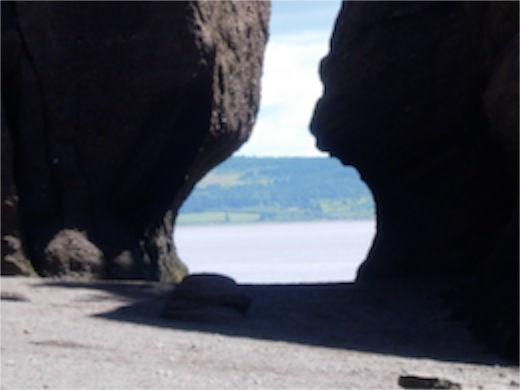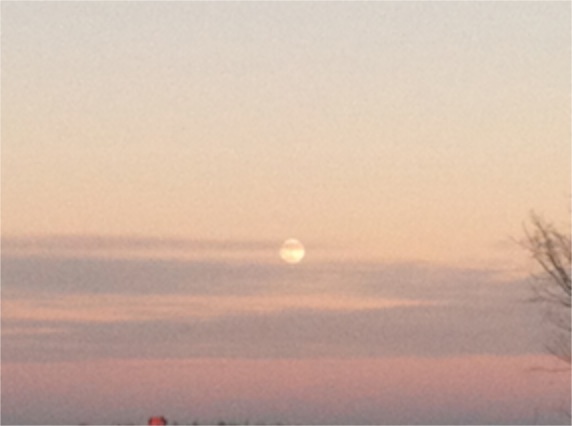Looking up at night
04/05/12 05:36
There have been times in the history of people when we lived a bit closer to nature. If you don’t have electricity, you tend to sleep when it is dark and wake when it is light. That means that people living farther from the equator have more sleep time in the winter and less in the summer. Of course the human body has its own cycles of sleep and wakefulness and being awake during the night is common, perhaps even natural. In the days before everyone lived indoors in climate-controlled homes with electric lighting, folks were more aware of the cycles of the night sky.
It takes concentration and regular observation to discern the movement of the planets. But if you spend time outdoors at night in rural areas away from the bright lights of cities, it is difficult to ignore the moon. People measured time by the cycles of the moon. Many early calendars were based on the lunar cycle.
We are simply less aware.
 The ancients observed that the moon appears to be larger at certain times than at others. Part of the size of the moon is due to its location in the sky and the relationship of the moon to the sun. Looking through the earth’s atmosphere makes the moon appear bigger. When it is on the horizon, we look through more of the earth’s atmosphere than when it is directly overhead. But there are variations on how the moon appears at moonrise.
The ancients observed that the moon appears to be larger at certain times than at others. Part of the size of the moon is due to its location in the sky and the relationship of the moon to the sun. Looking through the earth’s atmosphere makes the moon appear bigger. When it is on the horizon, we look through more of the earth’s atmosphere than when it is directly overhead. But there are variations on how the moon appears at moonrise.
Sometimes the moon looks bigger because it is closer. Its orbit around the earth is not a circle, but an ellipse. The moon will reach the point closest to the earth in its orbit this evening. The event coincides with the full moon. Moonrise tomorrow will be nearly 8 p.m. here and the exact moment of the full moon comes at 9:35 p.m. The forecast calls for thundershowers, so we may not get a glimpse of it, but when the clouds part, the moonlight should be a bit brighter than usual.
If we lived closer to the coast we would also notice that the tide would be a bit higher than typical. Because the gravity of the moon affects the distribution of water around our planet, when the moon is closer, the change is a bit more dramatic.
A good place to observe the effect would be a large inlet, such as the Bay of Fundy, off of the east coast of Canada, where the change in the tides is very dramatic. In fact the shape of that particular bay results in the most extreme tides in the world. During the spring tide the variation can be as much as 48 feet. Spring tide is a reference to the time of greatest variation in tides, not to the season. It comes from a German word and refers to the tides springing up.
 We had the good fortune to be able to visit the Bay of Fundy in 2007. One afternoon I was kayaking on water that was at least 18 feet above the sand where we had walked the same morning. The currents in the bay can be impressive. In order to produce the tidal effect, every day 100 billion tons of seawater flows in and out of the bay. That’s a lot of water!
We had the good fortune to be able to visit the Bay of Fundy in 2007. One afternoon I was kayaking on water that was at least 18 feet above the sand where we had walked the same morning. The currents in the bay can be impressive. In order to produce the tidal effect, every day 100 billion tons of seawater flows in and out of the bay. That’s a lot of water!
All of this is courtesy of the moon.
There are a lot of persistent myths about the moon and its effects on us humans. The term “lunacy” comes from the moon and a belief that the moon has some sort of effect on human mental illness. If you talk to employees in nursing homes and psychiatric wards and emergency rooms they will frequently claim that they are busier and people are more upset when there is a full moon. Since the human body is nearly 75% water, it has been speculated that this might be the result of the gravity sloshing the water inside of us like it does the water of the ocean.
That’s probably not true. Tidal effect requires a lot more water than you have inside of a person. You don’t notice tides on lakes. It takes an ocean for the effect to be noticed.
Furthermore, studies don’t bear out the myths.
A 2005 study by Mayo Clinic, reported in the journal Psychiatric Services found no statistical difference in the number of psychiatric emergencies on the three nights surrounding the moon verses other nights.
A 1996 report in the American Journal of Emergency Medicine found no difference in emergency room visits at full moon verses other nights.
Bad Science columnist Benjamin Radford observes, “If police and doctors are expecting that full moon nights will be more hectic, they may interpret an ordinary night’s traumas and crises as more extreme than usual. Our expectations influence our perceptions, and we look for evidence that confirms our beliefs.”
I’m not convinced that the full moon, or even the moon a perigee (the point closest to the earth), has much of an effect on human behavior. I enjoy listening to the stories and theories, but I remain skeptical. However, there is one explanation that makes a bit of sense to me. It has been speculated that in times before electricity and mini-blinds to keep us insulated from what is going on outside, people were awake more during nights of the full moon. There was more light, more people were awake, they got into more trouble. It has even has been theorized that people behaved more strangely because they were getting less sleep. Sleep deprivation can make folks behave in strange ways.
That may have been true in the past, but it hardly makes sense in our modern world. People are more likely to loose sleep for reasons other than the amount of moonlight.
 For me, the full moon is an opportunity to try to get another picture of the moon. I like to try to photograph it, though it always appears to be more beautiful in person than in the photographs I take. My pictures always produce an image of a moon that is tiny and far away.
For me, the full moon is an opportunity to try to get another picture of the moon. I like to try to photograph it, though it always appears to be more beautiful in person than in the photographs I take. My pictures always produce an image of a moon that is tiny and far away.
After all, tomorrow night when it is as close as it gets, the moon will still be 221,473 miles away.
It takes concentration and regular observation to discern the movement of the planets. But if you spend time outdoors at night in rural areas away from the bright lights of cities, it is difficult to ignore the moon. People measured time by the cycles of the moon. Many early calendars were based on the lunar cycle.
We are simply less aware.

Sometimes the moon looks bigger because it is closer. Its orbit around the earth is not a circle, but an ellipse. The moon will reach the point closest to the earth in its orbit this evening. The event coincides with the full moon. Moonrise tomorrow will be nearly 8 p.m. here and the exact moment of the full moon comes at 9:35 p.m. The forecast calls for thundershowers, so we may not get a glimpse of it, but when the clouds part, the moonlight should be a bit brighter than usual.
If we lived closer to the coast we would also notice that the tide would be a bit higher than typical. Because the gravity of the moon affects the distribution of water around our planet, when the moon is closer, the change is a bit more dramatic.
A good place to observe the effect would be a large inlet, such as the Bay of Fundy, off of the east coast of Canada, where the change in the tides is very dramatic. In fact the shape of that particular bay results in the most extreme tides in the world. During the spring tide the variation can be as much as 48 feet. Spring tide is a reference to the time of greatest variation in tides, not to the season. It comes from a German word and refers to the tides springing up.

All of this is courtesy of the moon.
There are a lot of persistent myths about the moon and its effects on us humans. The term “lunacy” comes from the moon and a belief that the moon has some sort of effect on human mental illness. If you talk to employees in nursing homes and psychiatric wards and emergency rooms they will frequently claim that they are busier and people are more upset when there is a full moon. Since the human body is nearly 75% water, it has been speculated that this might be the result of the gravity sloshing the water inside of us like it does the water of the ocean.
That’s probably not true. Tidal effect requires a lot more water than you have inside of a person. You don’t notice tides on lakes. It takes an ocean for the effect to be noticed.
Furthermore, studies don’t bear out the myths.
A 2005 study by Mayo Clinic, reported in the journal Psychiatric Services found no statistical difference in the number of psychiatric emergencies on the three nights surrounding the moon verses other nights.
A 1996 report in the American Journal of Emergency Medicine found no difference in emergency room visits at full moon verses other nights.
Bad Science columnist Benjamin Radford observes, “If police and doctors are expecting that full moon nights will be more hectic, they may interpret an ordinary night’s traumas and crises as more extreme than usual. Our expectations influence our perceptions, and we look for evidence that confirms our beliefs.”
I’m not convinced that the full moon, or even the moon a perigee (the point closest to the earth), has much of an effect on human behavior. I enjoy listening to the stories and theories, but I remain skeptical. However, there is one explanation that makes a bit of sense to me. It has been speculated that in times before electricity and mini-blinds to keep us insulated from what is going on outside, people were awake more during nights of the full moon. There was more light, more people were awake, they got into more trouble. It has even has been theorized that people behaved more strangely because they were getting less sleep. Sleep deprivation can make folks behave in strange ways.
That may have been true in the past, but it hardly makes sense in our modern world. People are more likely to loose sleep for reasons other than the amount of moonlight.

After all, tomorrow night when it is as close as it gets, the moon will still be 221,473 miles away.